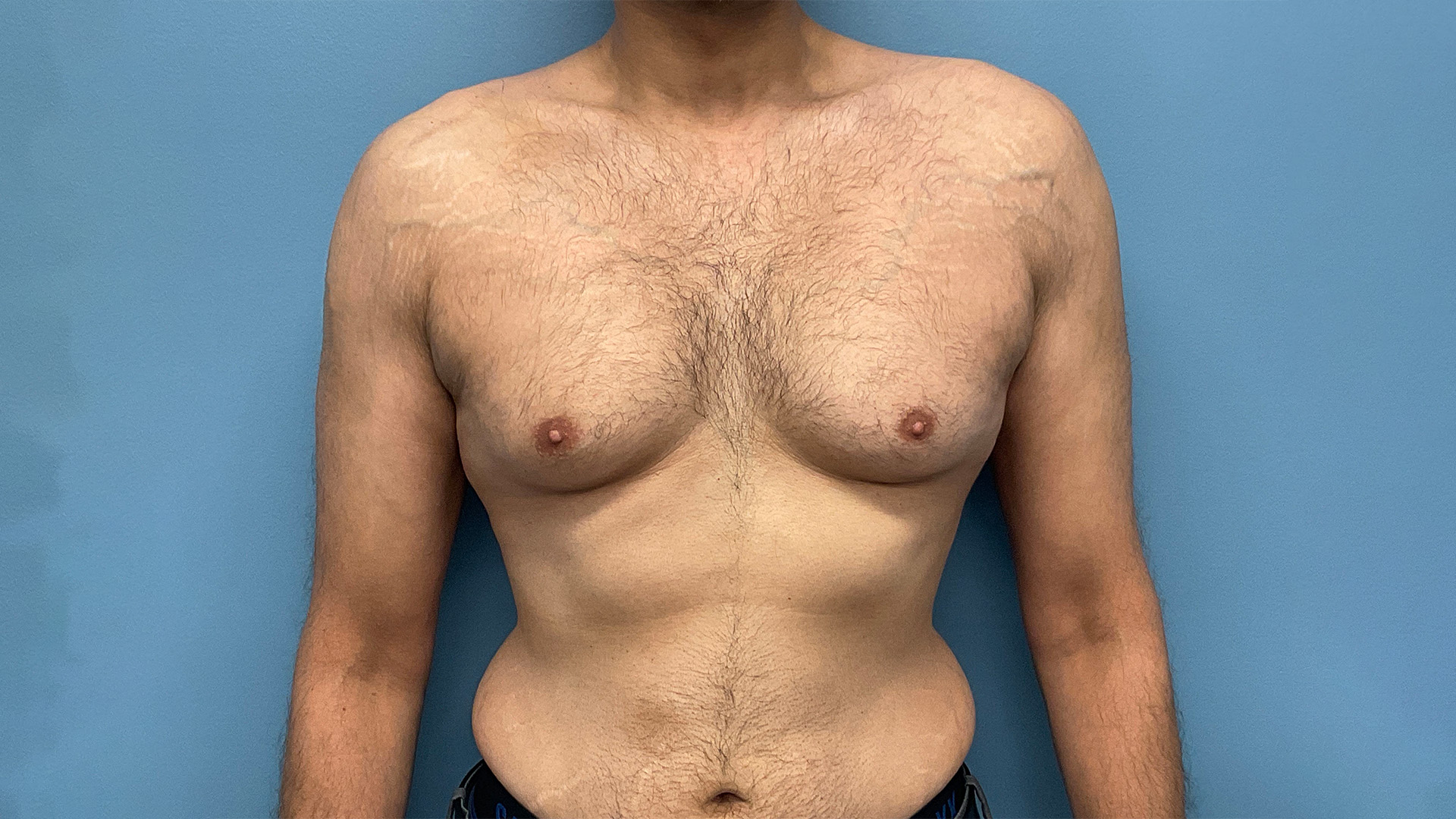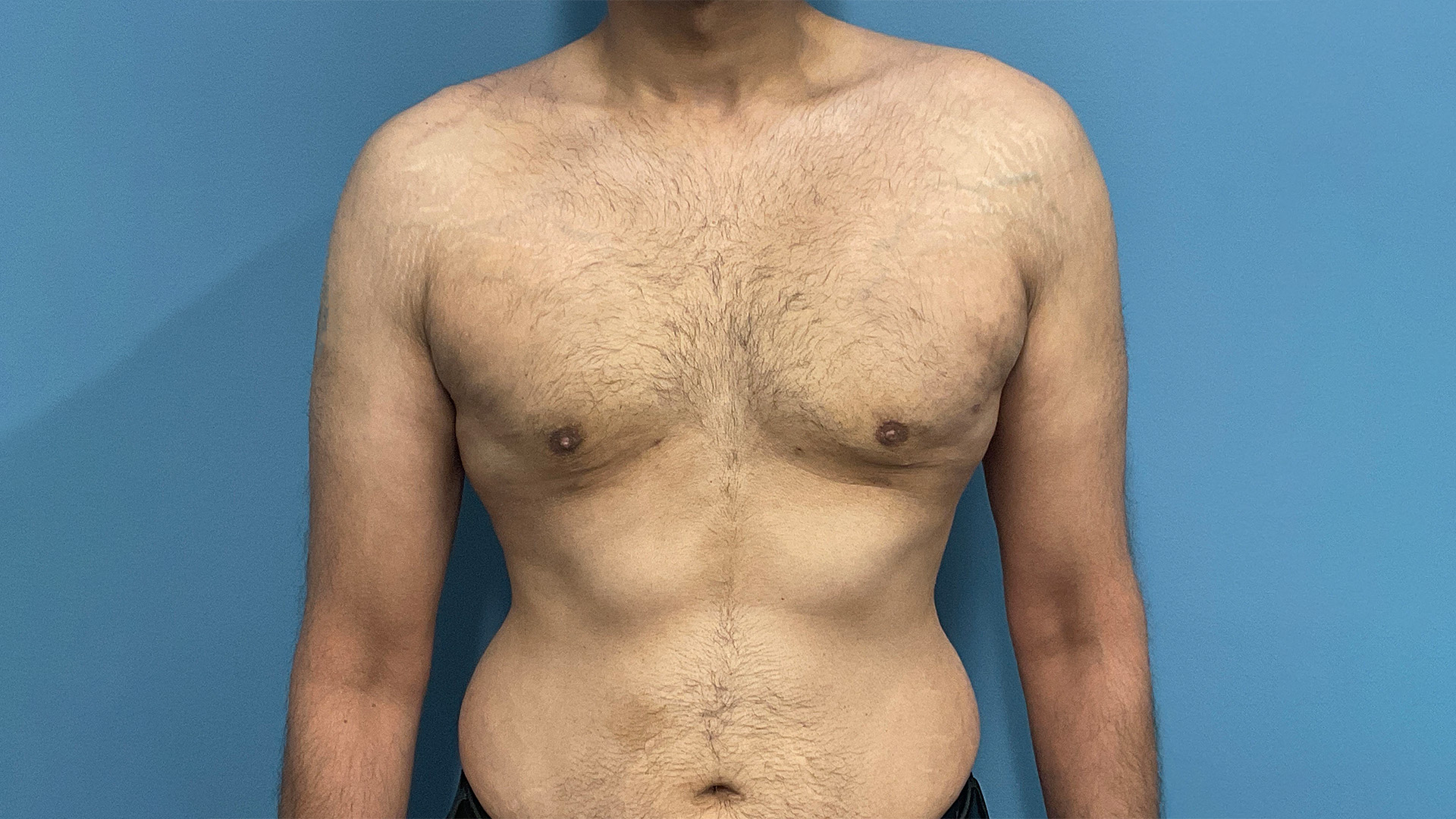Dr. Domanski’s surgical skills are complemented by his compassionate bedside manner. He got me through a scary situation, and really listened to what I had to say. A winning combination of art and science and an excellent medical practitioner..
Gynecomastia surgery is typically performed under general anesthesia or local anesthesia with sedation.
Swelling and bruising are common after gynecomastia surgery and may persist for a few weeks.
Initially, the scars may appear red and raised, but they will gradually fade and flatten over time.
Gynecomastia is the condition of enlarged or over-developed breasts that are disproportionate to a man’s body. Gynecomastia surgery can help improve self-esteem and self-confidence.
Gynecomastia surgery is common, with tens of thousands of surgeries performed in the United States each year. Gynecomastia surgery is a common procedure in our DC, Virginia, Maryland region.
Dr. Domanski performs all his surgeries in either a certified surgery center or a hospital ambulatory surgical facility. The night or morning prior to surgery, we prefer patients to shower with chlorahexadine gluconate to reduce germs. Chlorahexadine gluconate can be purchased at your local pharmacy without a prescription. You should have nothing to eat or drink after midnight prior to surgery.
Dr. Domanski meets patients again in the preoperative holding area. At this time, he reviews again the goals of the procedure and the surgical plan. The areas of gynecomastia are marked with a special pen. In this way, the patient and Dr. Domanski are both involved in the decision on what areas of gynecomastia to focus most on.
Surgical treatment of gynecomastia can involve excision of the underlying tissue with liposuction, liposuction combined with an incision on the underside of the areola, or skin excision as well.
Liposuction can work well for men with good skin tone and more fatty gynecomastia. This technique has the least external excisions.
Men with gynecomastia that is more glandular in nature may require an incision on the underside of the areola to remove the gynecomastia. Often liposuction is added to smooth out the surrounding tissue.
Men where the gynecomastia has produced extra skin may require skin excision.
Most gynecomastia procedures are performed with the patient under anesthesia. This means the patient does not remember or feel anything. Sometimes, liposuction alone can be used to treat gynecomastia. However, as gynecomastia is due to breast tissue, an open approach is the most common.
During the open approach an access incision is made under the areola. Placement of the incision at the junction of pigmented and non-pigmented skin helps hide the incision. Breast tissue is dissected free from the chest wall.
Gynecomastia surgery, also known as male breast reduction surgery, is a surgical procedure performed to correct the condition of gynecomastia. Gynecomastia is the enlargement of breast tissue in males, resulting in a more feminine chest appearance. It can occur due to hormonal imbalances, genetics, certain medications, or other underlying factors.
During gynecomastia surgery, the surgeon aims to remove excess glandular tissue, fat, and sometimes excess skin to create a more masculine and flatter chest contour. The specific surgical technique employed will depend on the extent of gynecomastia and individual factors.
Some common techniques include:
Gynecomastia surgery is typically performed under general anesthesia or local anesthesia with sedation, depending on the complexity of the procedure and the surgeon’s preference. The surgery can often be performed on an outpatient basis, allowing the patient to return home on the same day.
After the surgery, the patient will be required to wear a compression garment to provide support to the chest area and aid in the healing process. There will be some post-operative swelling, bruising, and discomfort, which can be managed with pain medication prescribed by the surgeon. The recovery time varies but typically involves a few days of rest followed by a gradual return to normal activities within a few weeks.
It’s important to consult with a qualified plastic surgeon experienced in gynecomastia surgery to determine the most appropriate technique for your specific condition. The surgeon will evaluate your individual case, discuss the potential risks and benefits, and develop a personalized treatment plan to achieve a more masculine chest contour.
Gynecomastia is the condition of enlarged or over-developed breasts that are disproportionate to a man’s body. Man breast reduction (gynecomastia surgery, man boob reduction) can help improve self-esteem and self-confidence.
Both men and women are born with breast tissue. In women, breast tissue develops during puberty. In some men, for reasons not always understood, the breast tissue develops as well. This is called gynecomastia. Weightlifting, exercise, and weight loss rarely help with gynecomastia because it is caused by actual breast tissue. Treatment for gynecomastia is removal of the breast tissue.
Gynecomastia surgery is common, with tens of thousands of surgeries performed in the United States each year. Gynecomastia surgery is a common procedure in our DC, Virginia, Maryland region.
In Seinfeld’s popular, “manssiere” television episode, George Costanza fear of developing manboob inspires Kramer’s to invent “the Bro,” a male undergarment for breast support.
This vintage 1995 television episode brought manboobs into the public consciousness. Yet, manboobs, otherwise known as gynecomastia, have always troubled those effected.
Men with gynecomastia know how it affects them.
Patients with gynecomastia often avoid pool parties, the beach, or wear two tee-shirts to avoid embarrassment. After gynecomastia surgery, there are many benefits. Patients feel comfortable wearing slimmer fitting clothing. Patients no longer avoid the beach or pool parties.
The term gynecomastia was termed by the Greek physician Galen (130-200 AD). The term derives from the Greek words “gyne” meaning woman and “mastos” meaning breast. The first description of surgical treatment of gynecomastia was recorded in the 7th century in Paulus’ text, Epitome of Medicine.
Dr. Domanski’s surgical skills are complemented by his compassionate bedside manner. He got me through a scary situation, and really listened to what I had to say. A winning combination of art and science and an excellent medical practitioner..
I am so happy with my results from Dr. Mark Domanski. I look so natural, all my friends are amazed. Would highly recommend
Had a great experience getting filler with Dr. Domanski. He took time explaining the processes and listened to exactly what I wanted. Loving the result!
I’m super picky about who I go to for beauty work. I’m just that person that does months and even years of research before choosing a doctor. Let me be the one to tell you that Dr. Mark Domanski is AMAZING! He is simply the best I’ve ever met. (…)
Dr. Domanski is such a skilled Professional. He makes you feel and look amazing, and always remembers me, and my friends who I have sent to him. He is extremely personable, which is rare these days. Go see him and you’ll definitely want to make it part of your routine:) Thanks Dr. D!
Dr. Domanski worked his magic and I am thrilled with the results. I highly recommend him for all your cosmetic needs!
Male breast reduction is performed to reduce breast size, flattening and enhancing the chest contour.
Modern treatment involves ruling out underlying causes such as hormonal imbalances, heavy marijuana use, or certain antipsychiatry medications. Most causes of gynecomastia are idiopathic, meaning arising spontaneously without a known cause. An analogy would be to try to determine why some women have AA breasts and others have DD breasts. There is usually no simple medical reason.
The ideal candidate is in generally good health. The candidate should not be on any medication that inhibits blood clotting. Smoking greatly increases the risk of healing problems.
Gynecomastia can be caused by medications, endocrinological disorders, and even marijuana. However, most cases do not have an identifiable cause.
During your initial consult, Dr. Domanski will review your goals, degree of gynecomastia, medical history, and options for the procedures. Many patients come for a preoperative visit, about two weeks before surgery, when we go over before and after care in more detail. Medications as prescribed at the preoperative visit.
Before and after results of our procedures.


The recovery process after gynecomastia surgery (male breast reduction) can vary from person to person, and it depends on several factors such as the extent of the procedure, individual healing abilities, and adherence to post-operative instructions. Here is a general overview of what to expect during the recovery period:
Immediately after surgery: After the surgery, you will be taken to a recovery area where you will be closely monitored by medical staff. You may experience some discomfort, swelling, bruising, and possibly drainage from the incision sites. Pain medication will be prescribed to manage any post-operative pain.
First few days: The first few days after surgery are typically the most uncomfortable, and it is important to rest and take it easy during this time. You will be advised to wear a compression garment or elastic bandages to provide support to the chest area and help reduce swelling. It is important to follow your surgeon’s instructions regarding dressing changes, wound care, and medication.
Swelling and bruising: Swelling and bruising are common after gynecomastia surgery and may persist for a few weeks. Keeping your chest elevated and applying cold compresses as recommended can help reduce swelling. The swelling will gradually subside over time.
Activity and exercise: It is important to avoid strenuous activities and exercise for a few weeks following surgery to allow for proper healing. Your surgeon will provide specific guidelines on when you can gradually resume normal activities and exercise routines. It is crucial to follow these guidelines to avoid complications and promote optimal healing.
Return to work: The timing of your return to work will depend on the nature of your job and the extent of the surgery. Some individuals may be able to return to work within a week, while others may require more time off. Your surgeon will provide guidance on when it is safe to return to work.
Scarring: Incisions made during gynecomastia surgery will result in scars. Initially, the scars may appear red and raised, but they will gradually fade and flatten over time. Your surgeon may provide instructions on scar care and recommend products to help minimize the appearance of scars.
Follow-up appointments: It is important to attend follow-up appointments with your surgeon as scheduled. These appointments allow the surgeon to monitor your healing progress, remove any sutures or drains if necessary, and address any concerns or questions you may have.
The complete recovery period can range from several weeks to a few months, depending on individual factors. It is crucial to follow your surgeon’s instructions, take any prescribed medications, wear compression garments as directed, and maintain open communication with your surgical team throughout the recovery process.
Remember that every individual heals at their own pace, so it is important to be patient and give your body the necessary time to heal properly. If you have any concerns or notice any unusual symptoms during the recovery period, it is important to contact your surgeon for guidance and advice.
With over 70 plastic surgeons in the area, patients choose Dr. Domanski because they trust him. We believe you will not find a more honest surgeon than Dr. Domanski.
“Be Yourself,
Everyone Else Is Taken.”
– Oscar Wilde
Don’t see a procedure listed? Request a consultation with us.